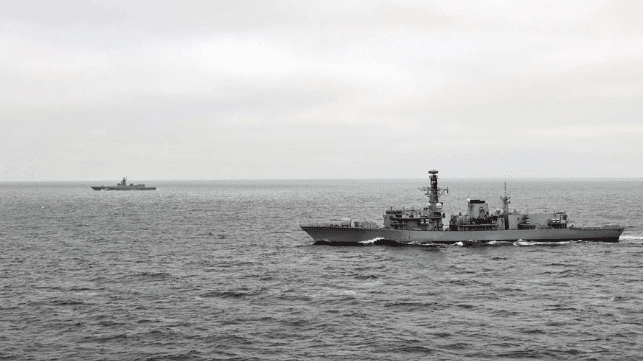Royal Navy Tracks Two Russian Task Forces Through UK Waters
UK Navy Monitors Russian Ships Near British Waters for a Whole Week

Over the past seven days, the Royal Navy, the Royal Fleet Auxiliary, and the RAF have been on high alert as two groups of Russian ships moved past the UK.
British warships, helicopters, support ships, and long-range patrol aircraft kept a close eye on two Russian naval groups. One group was heading toward the Atlantic, while the other was making its way to the Baltic. Both groups passed through the English Channel, with British forces watching every move.
Keeping a Close Eye on Russian Ships
Portsmouth’s HMS Iron Duke frigate, along with the support tanker RFA Tideforce, tracked the first group, led by Russia’s newest frigate, the Admiral Golovko. This frigate is part of the Admiral Gorshkov-class and was only put into service last Christmas. Alongside it were the oceanographic research vessel Yantar and the supply tanker Vyazma. Before the British forces took over, the Norwegian Navy had already been monitoring them.
HMS Iron Duke and RFA Tideforce followed the Russian vessels through the Dover Strait and the English Channel. Once they reached the end of the Channel, the French Navy took over monitoring duties. However, Yantar remained in the UK’s area of interest, so Portsmouth’s minehunter, HMS Cattistock, continued to keep a close watch on the survey ship.
DFDS to deploy fleet of battery electric vessels on the English Channel
A Second Russian Group Returns Home
While the Golovko and Vyazma sailed away, HMS Iron Duke then turned its attention to a second Russian group. This group was led by the Russian frigate Neustrashimy, which was heading home to the Baltic with its support ship, the tanker Akademik Pashin.
Iron Duke kept in contact with the Russian ships as they moved through the Channel and back into the North Sea. Once in the North Sea, a NATO ally – the Dutch warship HNMLS De Ruyter – took over escort duties, guiding the Russian vessels back to the Baltic Sea.
A Week of Careful Coordination
This operation involved a well-planned team effort. The Royal Navy used its Wildcat helicopter from the 815 Naval Air Squadron and a Merlin helicopter from the 814 Naval Air Squadron, based in Culdrose. They also used an RAF P8 Poseidon patrol aircraft and other allied aircraft to ensure every Russian move was tracked.
Commander David Armstrong, the Commanding Officer of HMS Iron Duke, said, “We have been part of this type of mission for the past six months, and it feels good to be back at it. We are protecting our waters and important infrastructure. My crew has now handled 11 escort missions, and I’m very proud of their dedication. This week was even more special since it coincided with Remembrance Sunday. We held a small ceremony onboard, honoring those who have fallen while continuing to serve our country.”
